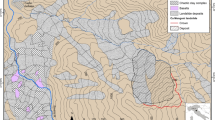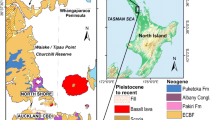Abstract
Flysch deposits are common in Serbia. Approximately 15 % of the 250 km of highways currently under construction will be constructed in flysch. In the most southern part of the E80 project, close to the border crossing with Bulgaria, construction of 3-km long cuts, often over 30 m high, is foreseen by the design. The geology of this part of Serbia is mainly characterized by flysch deposits represented by a sequence of sandstone and siltstone, interchanging in different proportions. After excavation of a majority of the cuts, several slopes suffered from global and structural instabilities. This required re-design of one part of the cuts. For this purpose, a geological strength index (GSI) was estimated and the structural features of rock discontinuities were observed on the faces of the surface excavations. This information and data obtained from laboratory testing enabled the determination of five characteristic rock mass types. For every type, shear strength properties were determined based on three criteria: the Hoek–Brown failure criterion; the Mohr–Coulomb criterion; and an hyperbolic nonlinear envelope. During the process of converting the Hoek–Brown parameters to the parameters of hyperbolic envelope, the Levenberg–Marquardt algorithm (LMA) was utilized to solve for the nonlinear regression problem. Verification of the parameters was performed on several examples. The median angle pressure increases exponentially with the GSI value and ranges between the value characteristic for clays and well-graded gravel. The maximum angle difference is obtained for a GSI value of 30. The average normal effective stress acting on the failed slopes, expressed in the form of the stress level ratio (SLR), is below 0.5. This indicates that the curved part of the shear strength envelope is utilized during the shearing. As such, the linear segment overestimates the shear strength.










Similar content being viewed by others
References
Balmer G (1952) A general analytical solution for Mohr’s envelope. Am Soc Test Mat 52:1260–1271
Barton NR (1973) Review of a new shear strength criterion for rock joints. Eng Geol 7:287–332
Botts M (1998) Effects of slaking on the strength of clay shales: a critical state approach. In: Proceedings of the 2nd international symposium on the geotechnics of hard soils/soft rocks, vol 1, Napples, Italy
Budetta P, Nappi M (2011) Heterogeneous rock mass classification by means of the geological strength index: the San Mauro formation (Cilento, Italy). Bull Eng Geol Environ 70:585–593
Coulson JH (1972) Shear strength of flat surfaces in rock. In: Coridng EJ (ed) Proceedings of the 13th symposium on rock mechanics, Urbana Illinois, pp 77–105
Dimitrijević M, Dragić D, Karamata S, Sikošek B, Veselinović D (1977) Explanatory booklet for the basic geological map of SFR Yugoslavia—Sheet Pirot 1:100 000. Federal geological survey, Belgrade (in Serbian), p 69
Gautam P, Shakoor A (2013) Slaking behavior of clay-bearing rocks during a one-year exposure to natural climatic conditions. Eng Geol 166:17–25
Gokceogly C, Ulusau R, Sonmez H (2000) Factors affecting the durability of selected weak and clay-bearing rocks from Turkey, with particular emphasis on the influence of the number of drying and wetting cycles. Eng Geol 57:215–237
Hoek E (1994) Strength of rock and rock masses. News J ISRM 2(2):4–16
Hoek E, Brown ET (1997) Practical estimates of rock mass strength. Int J Rock Mech Min Sci 34(8):1165–1186
Hoek E, Brown ET (1980) Underground excavations in rock. Institution of Mining and Metallurgy, London, p 527
Hoek E, Kaiser PK, Bawden WF (1995) Support of underground excavations in hard rock. Balkema, Rotterdam
Hoek E, Marinos P, Benissi M (1998) Applicability of the geological strength index (GSI) classification for very weak and sheared rock masses. The case of the Athens Schist Formation. Bull Eng Geol Environ 57(2):151–160
Hoek E, Carranza-Torres CT, Corkum B (2002) Hoek-Brown criterion-2002 edition. In: Proceedings of the NARMS-TAC conference, Toronto, vol 1, pp 267–273
Hoek E, Marinos P, Marinos V (2005) Characterization and engineering properties of tectonically undisturbed but lithologically varied sedimentary rock masses. Int J Rock Mech Min Sci 42(2):277–285
Hudson JA, Harrison JP (1997) Engineering rock mechanics—An introduction to the principles. Pergamon Press, Oxford, p 444
ISRM (2007) The complete ISRM suggested methods for rock characterization, testing and monitoring: 1974-2006. In: Ulusay R, Hudson JA (eds) Suggested methods prepared by the commision on testing methods. International Society for Rock Mechanics Compilation Arranged by the ISRM Turkish National Group Ankara, Turkey
Krahn J (2003) The 2001 R. M. Hardy lecture: the limits of limit equilibrium analyses. Can Geotech J 40:643–660
Krsmanovic D (1967) Initial and residual shear strength of hard rocks. Geotechnique 160:145–160
Li A, Merifield RS, Lyamin AV (2008) Stability charts for rock slopes based on the Hoek-Brown failure criterion. Int J Rock Mech Min Sci 45(5):81–89
Maksimovic M (1979) Limit equilibrium for nonlinear failure envelope and arbitrary slip surface. In: Proceedings of the 3rd Int Conf Num Meths Geomech, Aachen, pp 769–777
Maksimovic M (1989a) Non-linear envelope for soils. J Geotech Eng 115(4):581–586
Maksimovic M (1989b) On the residual shearing strength of clays. Geotechnique 39(2):347–351
Maksimovic M (1989c) Nonlinear failure envelope for coarse-grained soils. In: Proceedings of the 12th Int Conf SMFE, Rio de Janeiro, vol 1, pp 731–734
Maksimovic M (1992) New description of the shear strength for rock joints. Rock Mech Rock Eng Springer 25(4):275–284
Maksimovic M (1996) A family of nonlinear failure envelopes for non-cemented soils and rock discontinuities. Electron J Geotech Eng. http://www.ejge.com/1996/Ppr9607
Maksimovic M (2013) BGSLOPE Slope stability software package for PC
Marinos V (2007) Geotechnical classification and engineering geological behaviour of weak and complex rock masses in tunneling. Doctoral thesis, School of Civil Engineering, Geotechnical Engineering Department, National Technical University of Athens (NTUA), Athens
Marinos V (2010) New proposed GSI classification charts for weak or complex rock masses. Bull Geol Soc Greece XLIII 3:1248–1258
Marinos P, Hoek E (2001) Estimating the geotechnical properties of heterogeneous rock masses such as flysch. Bull Engg Geol Env 60:85–92
Marinos V, Marinos P, Hoek E (2005) The geological Strength index: applications and limitations. Bull Eng Geol Environ 64:55–65
Marinos V, Fortsakis P, Prountzopoulos G (2006) Estimation of rock mass properties of heavily sheared flysch using data from tunnelling construction. In: Proceedings of the 10th IAEG, Nottingham, p 314
Miscevic P, Vlastelica G (2011) Durability characterization of marls from the region of Dalmatia. Croatia Geotech Geol Eng 29:771–781
Miscevic P, Vlastelica G (2014) Impact of weathering on slope stability in soft rock mass. J Rock Mech Geotech Eng 6(3):240–250
Patton FD (1966) Multiple modes of shear failure in rock and related materials. Thesis, University of Illinois
Pepe G, Piazza M, Cevasco A (2014) Geomechanical characterization of a highly heterogeneous flysch rock mass by means of the GSI method. Bull Eng Geol Environ. doi:10.1007/s10064-014-0642-4
Picarelli L, Urciuoli G, Mandolini A, Ramondini M (2006) Softening and instability of natural slopes in highly fissured plastic clay shales. Nat Hazards Earth Syst Sci 6:529–539
Ripley CF, Lee KL (1962) Sliding friction tests on sedimentary rock specimens. Proc Seventh Congress on Large Dams 4:657–671
Rocscience Inc. (2013) Roclab user’s guide
Rocscience Inc. (2014) Dips user’s guide
Santi P, Higgins J (1998) Methods for predicting shale durability in the field. Geotech Test J 21(3):195–202
Sari M (2012) An improved method of fitting experimental data to the Hoek–Brown failure criterion. Eng Geol 127:27–35
Synergy Software (2013) KaleidaGraph guide
Tziallas GP, Saroglou H, Tsiambao G (2013) Determination of mechanical properties of flysch using laboratory methods. Int J Rock Mech Min Sci 166:81–89
Zainab M, Kamaruzaman M, Cho Gye C (2007) Uniaxial compressive strength of composite rock material with respect to shale thickness ratio and moisture content. Electron J Geotech Eng. http://www.ejge.com/2007/Ppr0755/Ppr0755.pdf
Author information
Authors and Affiliations
Corresponding author
Rights and permissions
About this article
Cite this article
Berisavljević , Z., Berisavljević , D. & Čebašek, V. Shear strength properties of Dimitrovgrad flysch, Southeastern Serbia. Bull Eng Geol Environ 74, 759–773 (2015). https://doi.org/10.1007/s10064-014-0678-5
Received:
Accepted:
Published:
Issue Date:
DOI: https://doi.org/10.1007/s10064-014-0678-5




